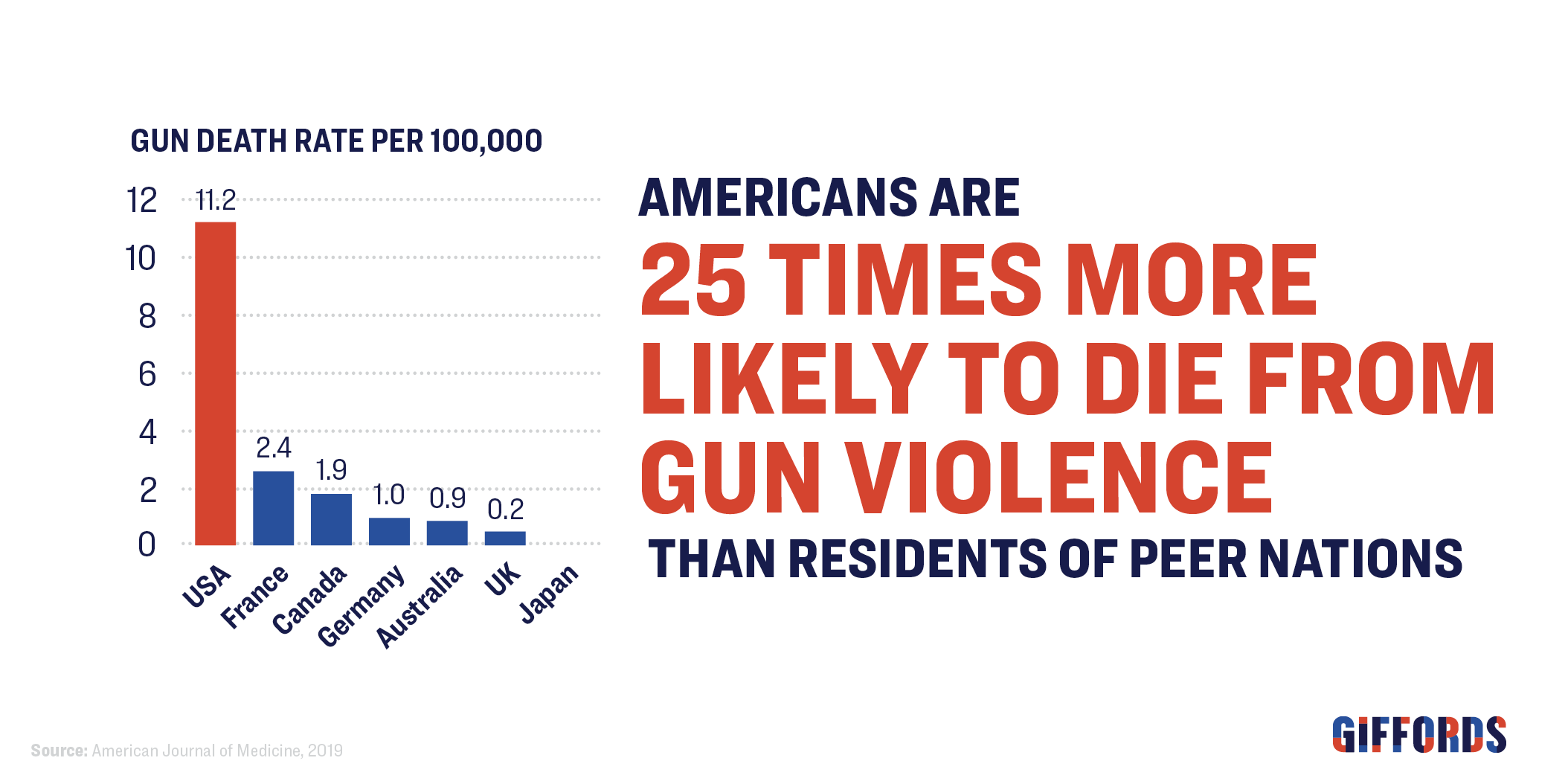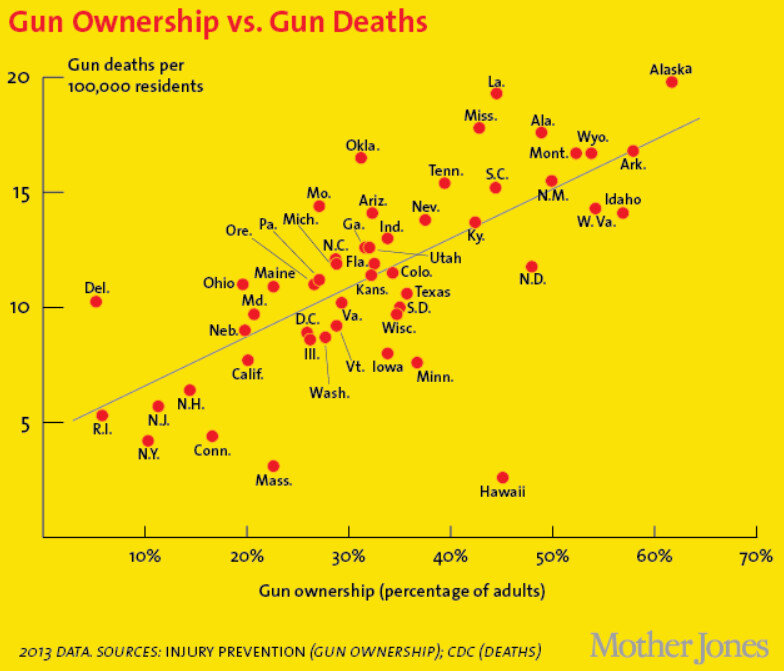Preliminary Research
Because this project was purpose rather than profit-driven, the project began with an open-ended review of published data to determine the size and nature of the problem, identify currently proposed solutions and provide the context for the solution we would eventually produce. Some of the sources and thinking that informed our solution are described below.
Background
The problem of gun-related deaths in the U.S. is larger than that of any other developed country and, despite the horror of recent (and ever more common) mass shootings, no workable solution is on the horizon. Even as gun-related casualties rise, even the most common sense regulations cause enough political friction to halt all forward progress. The statistics are an international source of vicarious embarrassment because would be a national embarrassment — a disgrace that Americans are too shameless to see.
A Growing problem
Gun-related deaths in the U.S. are on the rise. According to data gathered by the Centers for Disease Control and prevention, “the gun death rate hit 12.2 per 100,000 people in 2017, up from 12 in 2016 and 10.3 in 1999 (the earliest year of data available).” Suicide, mass shootings, and hate crimes are also on the rise, and many of these involve a firearm. (In 2017, three quarters of all murders (14,542 out of 19,510) and around half of all suicides (23,854 out of 47,173) involved a gun.) Efforts to curb gun violence through regulation have meet with unrelenting resistance from both the gun lobby and gun owners themselves. Even regulatory initiatives that are agreed upon by both sides of the debate seem destined to remain on the shelf as politicians use the subject as a platform to stir their respective bases and generate further polarization — without making any meaningful progress on the issue itself.
“The total gun death rate surpassed the car crash death rate of 11.9 per 100,000 people, as the rate of car crash deaths has steadily decreased while the gun death rate has increased over the years.”
Regulation-based solutions are necessary, but despite even the horrors of recent mass shootings, these solutions are often stillborn due to the hardening effect they have on the gun owners they target. The resulting polarization hinders the adoption of effective and bipartisan gun control regulations that could be saving lives today.
A Polarizing Problem
The power to meaningfully address this tragic and growing problem lies in the hands of gun-owning voters — not politicians. Though gun owners and non-owners generally agree about some gun control policies (e.g. 77% of gun owners and 87% of non-owners support background checks for private sales and at gun shows), they disagree on most. Many of these disagreements stem from fundamental misunderstandings policymakers have regarding the role that guns fill in the lives of their owners. Because they haven’t sought to empathize and define as designers do, they don’t understand the defensive stance of gun owners, because they don’t understand that they’re defending ideals and experiences that are fundamental to their identities.
Even as necessary regulations are debated, it is urgent that those who want to implement effective and systemic change begin to think about parallel methods to curb gun-related deaths. To make a dent, these solutions must address the statistical aspects of the problem. To be implemented, they must make allies of the very individuals current solutions demonize.
“Fewer than 20 percent of American gun owners are even NRA members. The real power is with those voting gun owners, not the lobby group that purports to represent them.”
The Statistical Problem with current solutions
On a statistical level, one of the greatest challenges to meaningfully reducing gun-related deaths is the high rate of suicide. Due to the horror of mass shootings, most regulations are targeted at the perpetrators of violent crimes. The only result is bipartisan support for regulations that prevent the mentally ill from purchasing weapons. (However, since so many perpetrators of mass shootings are only diagnosed as mentally ill as a result of having committed a mass shooting, this agreement reads more like a condemnation of mass shootings.) There remains little agreement on other surprisingly controversial issues such as bans on assault-style weapons, high capacity magazines and other initiatives aimed at reducing the casualty rate of these (increasingly common) national tragedies.
Efforts to reduce gun-related murders receive bipartisan support. They make headlines and help the careers of politicians on both sides of the aisle. And while these efforts are extremely important, they’re targeted at less than half of the problem. CDC reports that more than 60% of gun-related deaths are attributed to suicide and another 3% are unintentional, involve law enforcement, or had undetermined circumstances. Though solutions must address violent crime, those that fail to address the other 63% of the problem don’t feel like real solutions.
% of Gun-Related Deaths by type (2017)
The individual Problem with Current Solutions
On an individual level, there is the problem of cultural misunderstanding between gun owners and policy makers. Most gun control policies target and demonize gun owners. Though not all agree on the politics associated with gun ownership, all can agree that demonization of the very voters needed to implement effective regulation is no path to progress.
There are many aspects that gun owners and non-owners agree on, including the horror of mass shootings, the adoption background checks, the negative effect of easily access to illegal firearms, and educating children about gun safety. Despite this, there is a fundamental understanding gap between gun owners and non-owners that must be closed in order for gun control proponents to win gun owners as allies. Rather than demonizing gun owners, it is vital that gun control advocates seek to understand the role guns fill in the the lives of their owners and create solutions that curb gun-related deaths without taking away this aspect of their identities.
“Amid the horrors of a mass shooting, it’s easy to forget that guns are social glue—and gun control efforts that don’t account for that will fail.”
Reduction: A comprehensive solution
Many solutions have been proposed to reduce gun-related deaths, but most treat only violent crime nearly all carry unintended side effects.
Right-to-carry laws are intended to deter crime by arming more people to stop a shooter. However, a recent study found that right-to-carry increased the rate of firearm homicides by 9% when homicide rates were compared state by state.
Greater legal access to guns has also yielded unintended negative effects. According to another study in the journal Science, a spike in gun sales after the Sandy Hook massacre in 2012 was found to have caused an additional 60 deaths overall, including 20 children, resulting from unintentional shootings.
The Lautenberg amendment which disqualifies people with a misdemeanor conviction for domestic violence from buying or owning weapons has led to a 17% reduction in “gun murders of female intimate partners,” according to a study by Standford University.
The repeal of the 1994 assault weapon ban has had a major effect on the death rates associated with mass shooting events. “Compared with the 10-year period before the ban, the number of gun massacres during the ban period fell by 37 percent, and the number of people dying from gun massacres fell by 43 percent. But after the ban lapsed in 2004, the numbers shot up again — an astonishing 183 percent increase in massacres and a 239 percent increase in massacre deaths.” (Louis Klarevas, University of Massachusetts at Boston)
An overall decrease in gun availability is the only proven way to reduce gun-related deaths attributed to violent crime, suicide and unintentional causes. When tracked by state or by country, statistics show that the rate of gun ownership closely matches the rate of gun deaths. Meanwhile, programs that limit the availability of firearms — like those implemented in Israel and Australia — have yielded fast and massive reductions in suicide, mass shootings, and gun-related deaths in general.
Reducing the overall availability of guns would make both legal and illegal gun markets expensive. The buyers of illegal firearms would have to spend more to attain one, while the owners of legal firearms would see the value of their investment(s) increase. Coupled with amnesty buyback programs and an increase in taxes on ammunition, these initiatives make make it more lucrative for a criminal to sell his or her gun back to the government than to use it for violent crimes.
“Look at Australia, which enacted a ban and mandatory buyback of more than 600,000 long guns following a mass shooting in 1996, effectively ending the problem of mass shootings (already rare) and halving gun deaths. ”
Reducing the overall number of guns in the U.S. is likely the only way to comprehensively reduce gun-related deaths from all causes. Only solutions that are supported by gun owners themselves will break the regulatory stalemate. And though this type of reduction could yield massive reductions in gun-related deaths and benefit current gun owners economically, no regulation will be accepted that strips gun owners of their lawful property unless an alternative is provided that offers the same elements that are fundamental to their identities. Such an alternative cannot be be adopted overnight, but over time — perhaps generations — alternatives that offer the sport, community, and power of firearms may act as methadone to ween Americans from our addiction to firearms.






